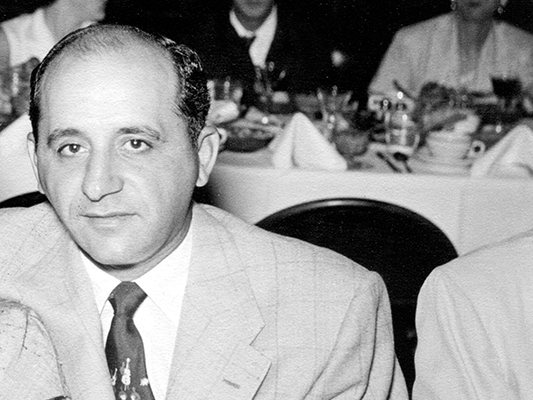Sam Giancana

Born: May 24, 1908, Chicago
(While he was born on May 24, Giancana preferred to celebrate his birthday on June 15.)
Died: June 19, 1975, Oak Park, Ill.
Nicknames: Momo, Mooney, Sam the Cigar
Associations: Tony Accardo, Frank Sinatra, Judith Exner, John F. Kennedy, Joseph Kennedy, Johnny Rosselli, Santo Trafficante Jr., the Outfit, CIA, Jack Ruby, Tony Spilotro, Phyllis McGuire
In the 1950s, Salvatore “Sam” Giancana became the leader of the powerful Chicago-based branch of the American Mob called the Outfit that was created by Al Capone. But his enduring notoriety comes from theories that put the Mob, and specifically Giancana and associates, at the center of conspiracies to assassinate President John F. Kennedy.
Born to a Sicilian immigrant family, Giancana was never afraid to use violence for profit. He was a member of a notoriously violent youth gang, the 42 Gang or the 42s. He served as a getaway driver and muscle. He was first arrested at age 17 for auto theft, and police believe he was responsible for at least three murders by the time he was 20, but he was not tried for any of those.
In 1926, Giancana was arrested and charged with murder, but inconveniently for the prosecution, a key witness died violently and the charges were dropped. He served jail or prison time for several offenses, including operating an illegal still, car theft and burglary. Several biographies say he was arrested more than 70 times for various offenses.
By the end of the 1930s, Giancana graduated out of the 42s into the Outfit.
In 1957, the Outfit’s top man, Tony “Joe Batters” Accardo, stepped aside and anointed Giancana, who had successfully consolidated illegal lottery rackets in Chicago through the tactic of murdering reluctant rivals, as his successor (though, in “retirement,” Accardo maintained considerable influence). Giancana was the Outfit’s representative to the national summit of Mob bosses held in Apalachin, New York, in that same year.
Like Accardo, who had a permanent second residence in Palm Springs, Calif., Giancana frequently spent time away from Chicago, and invested in Las Vegas as well as off-shore casinos in Iran, the Caribbean and Great Britain. Following the death of his wife, Angeline, in 1954, Giancana was linked to a series of attractive women, including the singer Phyllis McGuire and a call girl named Judith Exner, a woman who he allegedly would share with the future U.S. president, John F. Kennedy.
It was Giancana’s involvement with – some might say obsession with – politics that has provoked sustained interest in his legacy. Giancana knew Joseph Kennedy, the former ambassador to Great Britain and the father of the political dynasty that included his son, John F. Kennedy, the war hero, senator and finally president. Joseph Kennedy, who was involved with bootlegging operations during Prohibition, asked Giancana for help in rounding up votes for his son’s 1960 presidential campaign.
Illinois was critically important in the 1960 campaign, and Giancana’s ability to deliver votes in Chicago may well have clinched the presidency for John F. Kennedy. But one of President Kennedy’s first steps when he took office was to appoint his brother, Robert Kennedy, attorney general, and one of Robert’s priorities was going after the Mob.
This did not please Mob leaders, especially Giancana.
About the same time as the attorney general’s campaign to expose the Mob, Giancana and another Mob boss, Santo Trafficante Jr., were contacted by the CIA in a complex plot to assassinate Cuban leader Fidel Castro, who had kicked the Mob out of Cuba after his 1959 revolution. Chicago Outfit associate Johnny Rosselli, who also worked for Trafficante and at that point was working out of Las Vegas, was the go-between for at least part of this effort.
Then, on November, 22, 1963, President Kennedy was assassinated in Dallas. The conclusion of the Warren Commission, created by President Lyndon Johnson to investigate the assassination, was that leftist loner Lee Harvey Oswald acted alone in shooting the president. But theories persist that the Mob was somehow involved. Many of them link Giancana to the conspiracy, ostensibly because of his anger over Attorney General Robert Kennedy’s campaign against organized crime. However, very little hard evidence has been presented to show a Mob-led conspiracy to kill Kennedy.
In 1965, Giancana was jailed for refusing to testify before a Senate committee on organized crime, and in 1967 the national Mob Syndicate, tired of Giancana’s presence in the daily newspapers, took away his control of the Outfit.
Giancana moved to Mexico, but returned in 1974 to testify before another federal commission, this one examining the CIA’s efforts to kill Castro. While the reasoning is unclear, what happened the following year is not: Giancana, back in his Oak Park family home, had allowed someone he knew into his house. He was cooking his favorite meal of sausages when he was shot six times in the head, the first, apparently, from behind, a classic Mob execution.
Among the leading candidates as Giancana’s assassin was a young Outfit member named Tony Spilotro, who would go on to infamy in Las Vegas. There are so many unanswered questions about the Kennedy assassination, Judith Exner and the efforts to kill Castro that Giancana has become a central figure in the history and legends of the Mob.




